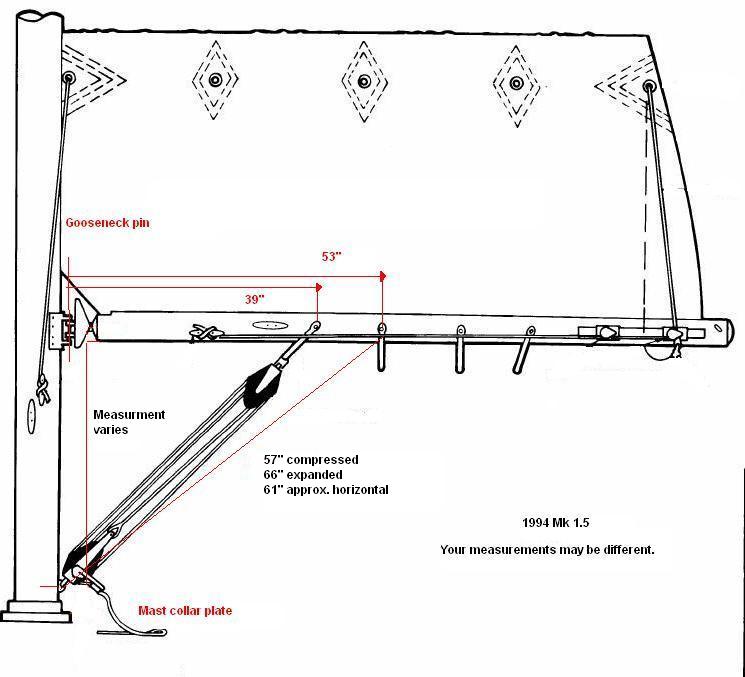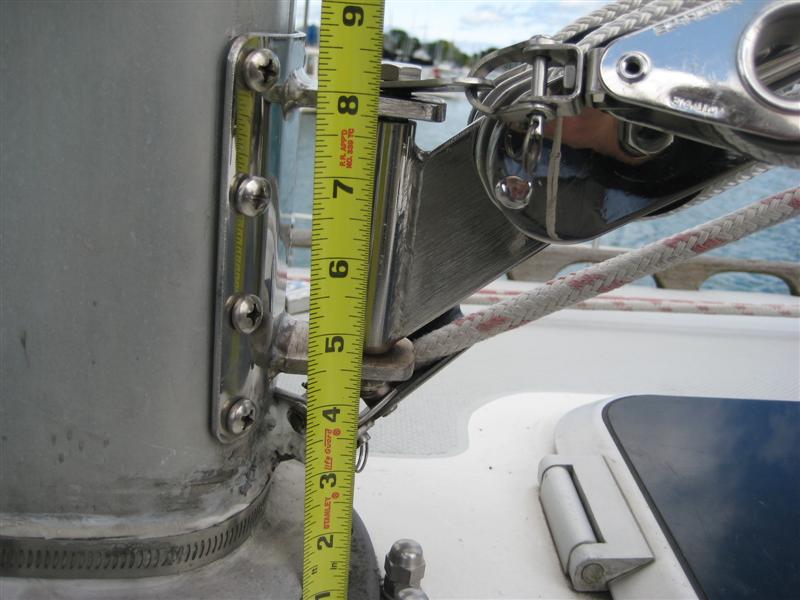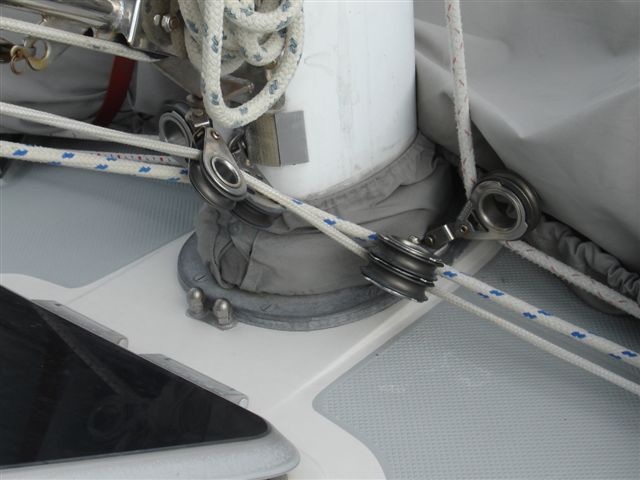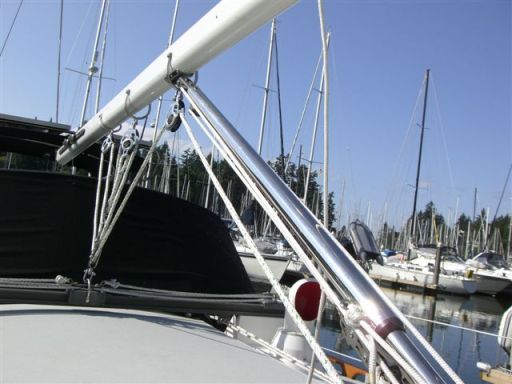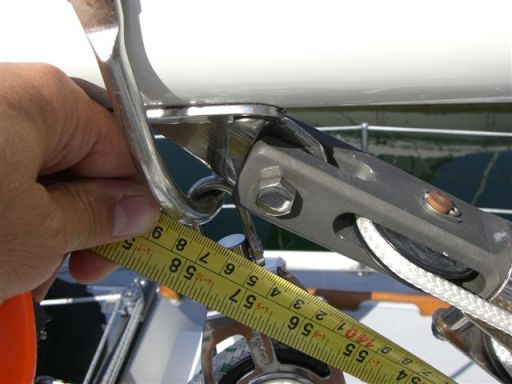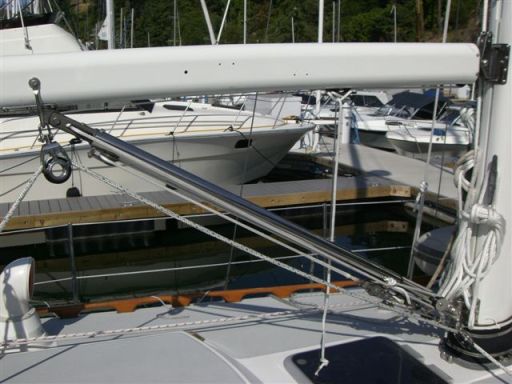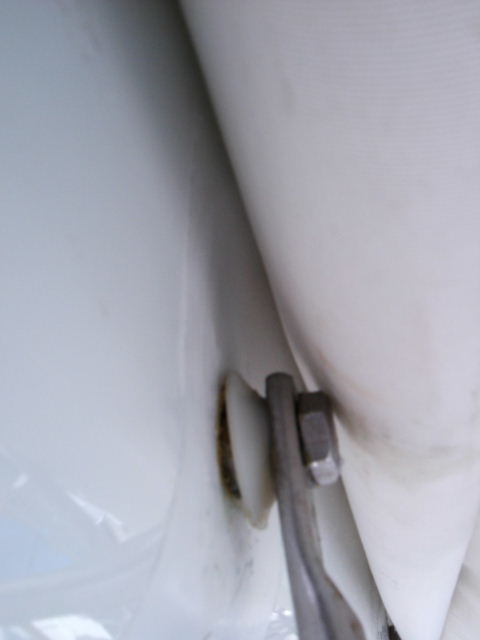Rigid Boom Vang Installation - Photos
The purpose of the vang is to exert downward pressure on the boom through a series of blocks to adjust sail shape. They are very useful, especially with the wind aft of the beam. The length and angle of the main sheet will adjust the sail's angle of attack, but will not pull the boom down to reduce the sail's draft. The advantage of the rigid vang is that the internal spring will support the weight of the mast doing away with the need for the topping lift.
Below are the instructions from their website;
Each boom vang is custom made for each boat. The measurements we would need are as follows:
1) The distance from the underside of boom straight down to the lowest point of the mast where the mast bracket can be mounted.
2) Templates of the aft part of mast and the underside of boom. A simple way of doing this is to take a piece of soldering wire and bend it around the aft part of mast, then trace the shape onto a piece of paper. Repeat the process on the underside of boom.
3) Size and make of boat.
Measurements can vary among the different years and models of the C34. Most C34’s have 4 boom bails, 3 for the mainsheet blocks and one forward for a soft vang toward the mast. (Page 4.1.7 of your owner’s manual.) Garhauer gave the pin to pin measurement of the vang both open and closed at 66” open and 57” closed, providing 9 inches of travel
Start by attaching the vang to mast as low as possible, other hardware will still need to use the small bail attached to the base of the mast, leave sufficient clearance. If you removed (not necessary) the vang from the bracket when installing the bracket, reattach and pull the lanyard to contract vang to minimum length.
Have somebody (or use the topping lift) hold the boom a little bit below the point at which it would hang with the sail up and the topping lift released. Another consideration might be your bimini, you may want to set the lowest point high enough to ensure bimini clearance. Attach the vang to boom at the point where it touches. Use the middle screws only at first. Give it dock trials with the main up. If you like it, put in the other 4 screws. If not move foreword or aft one set of screw holes.
The vang tucks neatly under the third bail. You don't need to remove the soft vang or buy different bails. As noted by Ron Hill in a Mainsheet article (pdf/1998_no4.pdf) that the mainsheet line must be rerouted from the last boom block (skipping the block below the goose neck) directly to the block at the base of the mast, then on to the turning block. So reroute your mainsheet and feel comfortable knowing it has been done before and it works....
Finished installation. Note that I left the soft vang attached to the boom to use as a preventer.
Another explaination of the installation process provided by "Black Dragon".
My rigid boom vang attaches as low as possible (just above an in-mast small bail) on the mast and about half way between the booms' "vang bail and the most forward mainsheet bail".
Truthfully, it's a pretty simple process. You want the foot of the vang as low down on the mast as possible. Then, with the vang completely compressed via its blocks, place the head of it against the boom at the lowest point you want the boom to go. Since the vang has a fair amount of expandability, I would advise you to set the boom's lowest point when the vang is fully-compressed to something less than 90 degrees. That way you'll have plenty of room to exert downward pressure on the boom if you need to really flatten the sail.
Next, with the foot of the vang securely in place on the mast, drill and tap the middle four holes for the vang's boom fitting. You want to do just the middle holes first in case you decide you need to move the vang forward or aft on the boom by an inch (thus the middle four holes would become either the aft- or forward-most holes). (Blackdragon)
Installation complete. Remember, the upward lift of the vang has no impact on sailing; it's simply there to keep the boom from crashing to the deck.
This bears repeating. Anytime anybody attaches stainless hardware to their mast: dip your fasteners in Lanacote (or Tefgel or whatever the modern high tech goo is called) and make sure to put a barrier between the hardware and the mast/boom: rubber, the paint on vinyl goo, or cut up milk jugs etc...
(Stu Jackson)
